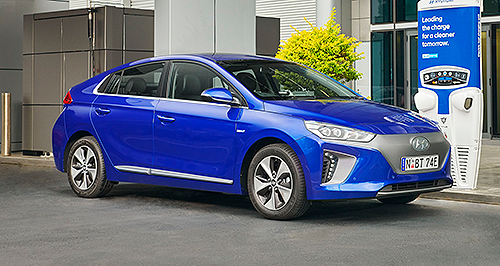Make / Model Search
News - General NewsRio shines as cheapest car to operate: RACVBaby grand: The RACV calculates that Kia’s Rio hatch (auto) costs $115.95 a week to keep it in the driveway, while Hyundai’s Ioniq Electric (left) – deemed the most affordable EV – comes in much higher, at $193.05. RACV survey shows EVs are cheap to run but total ownership costs are hard to swallow26 Jul 2019 By TERRY MARTIN KIA’S Rio city hatch has emerged as the most affordable new vehicle to own and run in Victoria, proving that small, lightweight models with a conventional combustion engine remain a better bet than even electric cars in terms of overall operating costs.
The RACV’s annual ‘Driving Your Dollars’ survey released this week shows that the Korean brand’s five-door light hatch – in entry-level S guise, with a 74kW/133Nm 1.4-litre petrol engine and automatic transmission – costs $6029.46 to keep in the driveway each year, which equates to $115.95 a week.
The figures are based on private motorists travelling 15,000km a year over a five-year period and compares the vehicle’s list price (and trade-in value) against running costs such as fuel, tyres and servicing and ‘standing’ charges like the initial on-road costs and ongoing annual expenses: registration, loan interest, licence fees, motoring club membership etc.
Depreciation is factored in, too.
The Rio’s bottom line is the lowest from a field of 141 models assessed across 14 categories – including 11 other light cars, three smaller micro cars (including Kia’s own Picanto) and seven full-electric and plug-in hybrid vehicles.
Hyundai’s small Ioniq Electric Elite was the best of the electrified vehicles, calculated as costing $10,038.80 a year to run, or $193.05 per week.
This compares to $11,340 a year ($75.60/week) for Renault’s Zoe Intens EV, $12,665.04 ($243.56) for Mitsubishi’s Outlander PHEV and $13,527.68 ($260.15) for Hyundai’s larger Kona Highlander Electric SUV – or up to $26,746.62 ($514.36) for the Tesla Model X 100D SUV.
The higher purchase price and hefty ongoing costs such as depreciation and interest blow the figures out for the EVs, but the actual running costs column – again, with assumptions made about electricity tariffs – show that electrified cars are nigh on unbeatable.
The Ioniq, for example, comes in at 6.65 cents per kilometre compared to the Rio at 13.26c/km.
We also note that the regular petrol-powered Kona Active FWD auto – priced from $25,500 plus on-roads compared to the Highlander Electric at $64,490 – emerged as the class leader among the small SUVs with annual operating costs of $8511.77 ($163.69/week), albeit with running costs of 14.82c/km compared to the EV’s 7.32c/km.
Among the light cars, Rio outshone the likes of the Suzuki Swift GL ($6124.14/$117.77) and Mazda2 Neo ($6854.65/$131.82) and premium models like the Mini Cooper hatch ($10,364.07/$199.31), while the best micro was the Picanto S at $6148.85 per annum ($118.25/week).
Kia’s Cerato S hatchback was also deemed the category winner for volume-selling small cars ($7105/$136.64), outperforming sales leaders such as Toyota’s Corolla Ascent sedan ($8580.57/$165.01), the Mazda2 G20 Pure hatch ($8869.83/$170.57 and Hyundai i30 Active hatch ($8211.06/$157.90).
Elsewhere, Toyota’s Camry Hybrid Ascent Sport took class honours for medium cars ($9880.48/$190.01), Holden’s imported Commodore RS 2.0T was deemed most affordable to operate among the remaining large cars on the market ($12,109.53/$232.88), Toyota’s 86 GT led the sportscar pack ($10,674.59/$205.28) and Honda’s Odyssey VTi was adjudged best people-mover ($11,319.52/$217.68).
Moving into SUV territory naturally sees the ‘reimbursement rates’ head north. Apart from Kona, class leaders included: Ford’s Escape Ambiente AWD mid-sizer ($10,315.94/$198.38), Subaru’s Outback 2.5i large SUV ($11,075.45/$212.99) and, among the 4x4 all-terrain wagons, Mitsubishi’s Pajero Sport GLX ($12,746.51/$245.13).
Utes? Mitsubishi’s Triton 2.4-litre GLX dual-cab was the winner in both the 4x2 and 4x4 section, the 4x2 taking overall honours with an annual cost of $11,374.00 ($218.73/week).
The most expensive vehicle to operate, based on the models assessed in the study and largely due to its high purchase price and associated standing costs, is BMW’s X5 xDrive30d ($23,417/$450.34).
Highest running costs go the way of Ford’s V8-powered Mustang coupe at 29.32c/km – the price its owners pay for the guilty pleasure of owning an old-school muscle car.
The RACV’s manager of vehicle engineering, Michael Case, said the annual survey “demonstrates the substantial costs of vehicle ownership”.
“Running for 50 years, the ‘Driving Your Dollars’ survey highlights the various costs associated with owning and operating a vehicle. The results remind drivers that a car continues to cost you, every week and every kilometre, and goes beyond your fuel fill-up,” he said.
Depreciation – not fuel, as one might expect – has the biggest impact on the bottom line, making up more than 40 per cent of overall costs. Fuel comes in third at 13.5 per cent, with on-road costs the second-biggest factor at 23 per cent.
Full results and an operating costs calculator tool are provided on the RACV’s website.
“The cost of owning a car doesn’t end after the purchase price, with many people neglecting the impact depreciation, on-road costs and loan repayments have on the hip pocket,” Mr Case said.
“That’s why we have developed a tool for drivers to see what Victoria’s most popular cars will cost them per week to run and operate.”
The RACV’s survey is specific to Victoria but broadly comparable – particularly in terms of the trends – to similar studies published by fellow state and territory motoring clubs.
That said, overall and individual category winners can vary between the states. For example, Kia’s Rio also won in Western Australia this year, but was edged out by the Mitsubishi Mirage in Queensland.  Read more |
Click to shareGeneral News articlesResearch General News Motor industry news |











Facebook Twitter Instagram